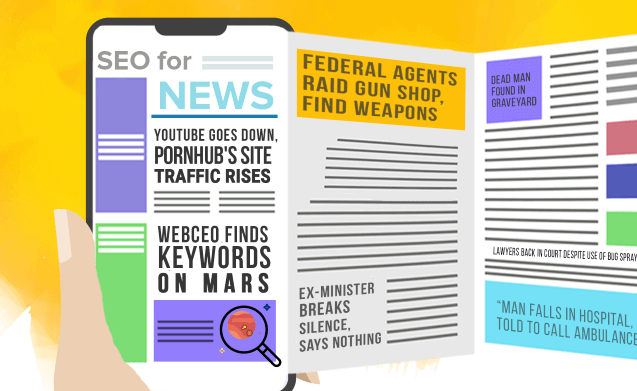
Have a digital magazine and website and want to do SEO for it? Search engine optimization for a new website can be intimidating because of the amount of information out there. Without experienced in-house SEO or consultant, this gets worse. So how to do SEO for a magazine website?
What is SEO?

Simply defined, SEO is the process of getting more readers through news or evergreen content. The intention is to boost the click-through rate on organic search engine results.
SEQ is the abbreviation of Search engine optimization, which is a strategy for improving online visibility in a web search engine’s unpaid results. It is also referred to or frequently addressed as “natural”, “organic”, or “earned” results. The higher you rank on top of the search engine page, the more likely you are to be viewed!
Step By Step Guide For Doing SEO For A Magazine
These are some critical but pivotal steps to do SEO for a magazine website and boost it in the simplest way possible:
1. Put the Keywords Aside

For bigger publication websites that may have 500+ to 10,000+ pages, forget about keywords. What you should do is ensure that the search engines can find every one of those pages. This results in higher page views because folks searching for specific items find and remember you. Do focus on key phrases like election news or hurricane alert.
2. Stand Out in Search Results

When we need an answer to our queries, we usually type it into a search engine. Research shows that almost 93% of online experiences begin that way. Then is the next step of clicking on one more or many of them. Opt for specific techniques that help get a high position in SERPs and high CTR at the same time.
3. Open Up your Website
Too many hands spoil the broth… You must have heard of this phase! Similarly, a website asking for too much means the user would avoid it accessing it. Here’s what can be done:
- Avoid the option of registration. More prominent publications worldwide are avoiding it because they know people don’t want to pay and get the same news through other sources. Search engines cannot get past a registration form — by using one, and you are merely cutting off all of the content behind that form.
- Whey keeps an archive to move old articles to a different address. If you do so, then the search engines will lose track of the old content. And there is a good chance that the older content was getting you a high ranking. It’s best to retain even the older articles on your site and move them to a separate page instead.
- Don’t redirect your home page elsewhere because every link you get at one address is potentially a vote lost at the other. Avoid redirecting and use the ‘www’ address. It helps in brand recall, and you’ll get more of those votes pointed at a single address.
4. Restructure the Website

- Keep the structure neat and user-friendly. Do have categories, but don’t make it so complicated that visitors won’t find a thing. Remember that Google reads and understands the internet, aim for at least 250 words per page. Have separate pages to target every one of your main keywords, services, or topics.
- Also, backlink articles to the hub page. Doing so increases the relevance of that page for the subjects discussed in the articles.
- Do have a search tool on your site to record searches performed. Use this tab as a benchmark to record visitor actions. Make sure the phrases that comprise the top 10% of searches are linked from the home page. Search engines work on structured strategies, and hence linking to this content from the home page will boost its relative importance.
- Link sensibly — you don’t want fashion connecting to sports and vice versa. Also, be very specific about naming them. Lack of clarity can keep both search engines and users guessing, which is a potential problem.
- Add categories and title gags. Ensure that the article title and section are in the title tag. A descriptive one lets the search engine immediately see that the page is about a particular topic.
- Headings should be in heading tags like H1, H2, H3, etc., and describe the page’s content. Sub-headings can be placed into lower-level heading tags so that the search engines can see the top-level ones.
- Add paragraphs of text in paragraph elements. Using line breaks and tables instead of paragraph tags helps in boosting ranking.
5. Clean, Simple Code
This partis a bit technical but can be done when you want to know how to do SEO for a magazine website.
- Getrid of the inline javascript to a separate js file. This helps to improve that ratio.
- Reduce bandwidth usage so that visitors’ browsers will cache the js include file the first time they visit the page. For returning visitors, this won’t load the older file from your server. It is just a small saving that adds up fast.
6. No Duplication, Please

- You must link consistently using the same address, all the time.
- Avoid using query attributes for insite tracking. Many add things like ?homepage=rightside’ to indicate that a particular click came from the page’s right side. Rather go for tools like ClickTracks or ClickTale to track click locations instead.
- For multi-page articles, most people put links at the bottom and top of the page. As a result, people jump from page 1 to 2 to 3, etc. But ensure that whenever they jump back, the page URL doesn’t have ?p=1″ or ‘p=0″ in it. If you are doing pagination, do ensure it doesn’t create duplication issues.
- Arrange your cookies and avoiding query attributes for sorting, either similar reasons as above. One has the option dynamically inserting a ROBOTS meta tag set to ‘noindex’ whenever you have a sorting query attribute.
- Consistently link to sections and don’t mix them — and this would create duplicate content. It’s recommended that you link back to the home page.
7. Your Blog and Content

Don’t dump press releases on your blog. If you feel you should have this on the website for compliance purposes — put it in a “Media” section. A rule of thumb for blogging is never to publish anything on your blog that you don’t think your target customers would want to read. While the visitors do have to pay to read your blog, they certainly don’t want to waste time on it right?
Here are a few other tips to keep in mind when you want to know how to do SEO for a magazine website, especially for a blog:
- Only have high-quality 100% unique content on your site
- Create pages based on priority
- Don’t have annoying ads and pop-ups
- Register with Google Search Console
- Optimize the core web vitals
- Go for a responsive, mobile-friendly design
Bonus Tips

While the above is good enough for your website SEQ, these bonus tips can give you a competitive edge. Let’s take a look:
- Even if you don’t need it, add an RSS feed for your latest articles. Place the entirety of every item into the feed and ensure that they have at least one link to another article on your site. Often, others may use software to plagiarise your RSS feed and use it to put content on their sites. In that case, it creates links back to you.
- Have an affiliate or reward program for others who link to you. For example, you can create a contest that encourages others to link to you. Keep in mind that links are votes and the more you get, the better shot at a high ranking for your various topics.
- Writing unique description tags helps search engines use them as the snippet in their results pages. It eventually means more clickability for your website.
- Do have a Google site map along with seeing a Google Webmaster Tools account. Ensure that they verify your site & use this data about crawl problems and links to improve your site further.
A magazine or an online publication can succeed when you focus on accessibility for your site along with SEO. The idea is that you should make it simpler and more comfortable for visitors to see exactly what each page is about — and that too in the shortest amount of time possible. When visitors find it easy to get from page to page, it automatically indicates that even the search engines are doing the same!
One should learn to focus on and create content around long-tail search phrases, which are based on SMM or social media marketing techniques rather than just giving importance to head keywords, which is social media. Link-building, in particular, is about quality and not quantity. And don’t forget about the shift from web pages to mobile-friendly websites!
